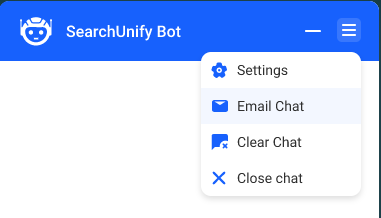An Overview of the SUVA Chat Window
Beginning with the Q2 '25 release, SUVA’s legacy chatbots will incorporate Agentic conversational capabilities, featuring streaming LLM response generation, enhanced conversational quality, and improved contextual understanding. For more details, read SUVA 25.04 DC Release Notes
This article details the structure and elements of the SUVA chat window. The appearance of the chat window is configurable from Theme Editor (only for those who are on the SUVA versions older than the Q3 '24 release).
NOTEA new, revamped Theme Editor is to be launched in the upcoming release. Please contact the SUVA team to request additional customizations and anything else unavailable in the Theme Editor.
The key elements of the chat window are:
-
User Input – User queries are entered in this section.
-
Send – Pressing this button posts the user query.
-
Minimize – Clicking on it minimizes the chat window.
-
Resize. Click this button to expand the chat window; click it again to return it to its original size.
- More Options. Clicking
 shows more options including:
shows more options including:Language. Language opens the languages section where you can select the language(s) of your choice. Changing the language here changes both the chat window's interface and the language of the interaction.
Download Chat. Clicking this option allows users to download their chat transcript.
Clear Chat. Clicking the third option from the list clears the chat history while the chat session continues.
-
Close Chat. Selecting this option closes the chat window and ends the chat session.
-
Response References. To know about the source of the chatbot response, users can click on references in the chatbot response. A summary is also added to every reference to help users identify the right one.
-
Chat Session Feedback – A mechanism to analyze the perceived usefulness of chatbot responses and conversations. When a user ends a session by closing the chat window, an emoticon-based feedback mechanism pops up to capture the overall experience of the user.
For traditional and LLM-powered chatbots, a thumbs-up and thumbs-down feedback pops up along with the chatbot responses (as shown in the image below). In LLM-powered chatbots, this feedback option is available for each bot response. For traditional bots, it appears at the end of a story (configured in the Story Board).
-
Rich Snippet Responses. Rich Snippet responses–text, image, video, or URL responses–are enabled from search clients and are visible only if they are active. Given below are some examples of how rich snippet responses appear in the SUVA chat window.
A) Image Responses
B) Video Response
C) Text (With Steps) Response
Last updated: Thursday, September 25, 2025







